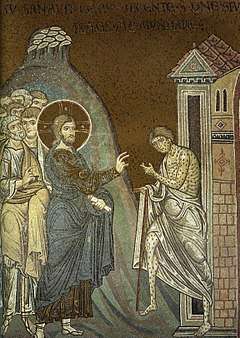Matthew 8:2
Matthew 8:2 is the second verse of the eighth chapter of the Gospel of Matthew in the New Testament. This verse begins the miracle story of Jesus cleansing a leper, the first of a series of miracles in Matthew.
| Matthew 8:2 | |
|---|---|
← 8:1 8:3 → | |
 A medieval mosaic of Christ and the Leper | |
| Book | Gospel of Matthew |
| Christian Bible part | New Testament |
Content
In the original Greek according to Westcott-Hort this verse is:
- και ιδου λεπρος προσελθων προσεκυνει αυτω
- λεγων κυριε εαν θελης δυνασαι με καθαρισαι
In the King James Version of the Bible the text reads:
- And, behold, there came a leper and worshipped him,
- saying, Lord, if thou wilt, thou canst make me clean.
The English Standard Version translates the passage as:
- And behold, a leper came to him and knelt before him,
- saying, “Lord, if you will, you can make me clean.”
Analysis
This verse provides a rapid introduction to the story of the miracle. Where and when it is happening is not told, nor is any information on the leper, including his name. This is a common structure in miracle literature of the time.[1] While the disease is universally translated as leprosy, it does not refer to the disease as today defined, but rather to any skin condition. Those with such conditions were generally shunned and excluded from society.[1]
"And behold" is a phrase that Matthew uses often to emphasize the importance of a section, often using it to begin miracles.[2] Matthew also adds lord to his version, again emphasizing the importance of Jesus.[3] Lord in Matthew is only used by disciples and followers of Jesus, it was not a term of general politeness.[4]
This story of the Leper occurs in both Mark and Luke, with this verse being paralleled by both Mark 1:40 and Luke 5:12. Of much interest to scholars is that Lord appears in both Matthew and Luke, but not in Mark. This contradicts the generally accepted Two-source hypothesis. These matching changes imply that Luke was working from Matthew, or that they both may have been working from an edition of Mark that differs from the standard one now extant.[5] Davies and Allison don't put much weight on this evidence, noting that both Matthew and Luke add the word Lord to their narratives, and may very well have coincidentally done so here.[1]
Kneeling before someone or something in scripture is a regular motif for worship and adoration, and Matthew has 41 other figures do so over the course of the gospel.[6] It implies that Jesus is a figure for adoration, on a level equal with the Temple.[1] The leper does not ask Jesus to ask God to heal him, but rather asks Jesus himself, evidence the advanced Christology in Matthew.[4]
References
- William David Davies; Dale C. Allison (Jr.) (1988). Matthew Vol 2. Clark. p. 11.
- Schweizer, Eduard. The Good News According to Matthew. Atlanta: John Knox Press, 1975 pg. 210
- Gundry, Robert H. Matthew a Commentary on his Literary and Theological Art. Grand Rapids: William B. Eerdmans Publishing Company, 1982. pg 139
- Ulrich Luz (January 2001). Matthew: 8-20. Fortress Press. p. 6. ISBN 978-0-8006-6034-5.
- Gundry, Robert H. Matthew a Commentary on his Literary and Theological Art. Grand Rapids: William B. Eerdmans Publishing Company, 1982. pg 139
- Schweizer, Eduard. The Good News According to Matthew. Atlanta: John Knox Press, 1975 pg. 210
| Preceded by Matthew 8:1 |
Gospel of Matthew Chapter 8 |
Succeeded by Matthew 8:3 |